Abstract
Toxic shock syndrome toxin-1 (TSST-1), isolated from Staphylococcus aureus strains associated with toxic shock syndrome (TSS), is known as a potent mitogen and interleukin-1 inducer. The potential of TSST-1 as an interleukin-2 (IL-2) inducer was tested on human peripheral blood lymphocytes (HPBL) and murine spleen lymphocytes (MSL). These cells were incubated with TSST-1 and the supernatants analysed for IL-2 production. Preincubation of IL-2-dependent indicator cells (IC) with a monoclonal antibody specific for murine IL-2 receptors inhibited their proliferation by supernatants of TSST-1-treated MSL, thus strongly suggesting that they contain IL-2. The concentrations of TSST-1 required for HPBL or MSL to produce IL-2 ranged between 10(-1) and 10(-4) micrograms/ml. The amount of IL-2 units/ml varied little from one experiment to another. In contrast, IL-2 production by PHA-stimulated HPBL or Con A-stimulated MSL showed great variability and dependence on mitogen concentration. T-cell depleted MSL exposed to TSST-1 produced less IL-2. Experiments with germ-free mice and TSST-1-primed mice demonstrated that IL-2 production is not related to TSST-1 antigenicity.
Full text
PDF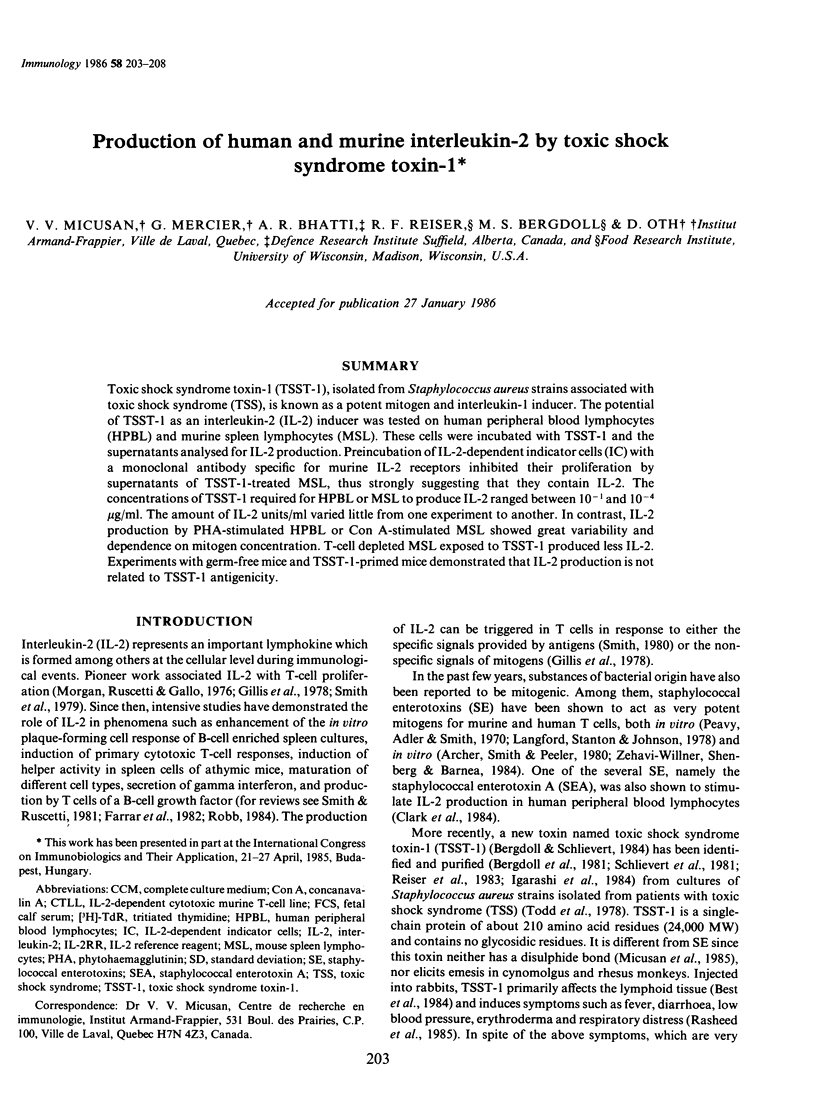
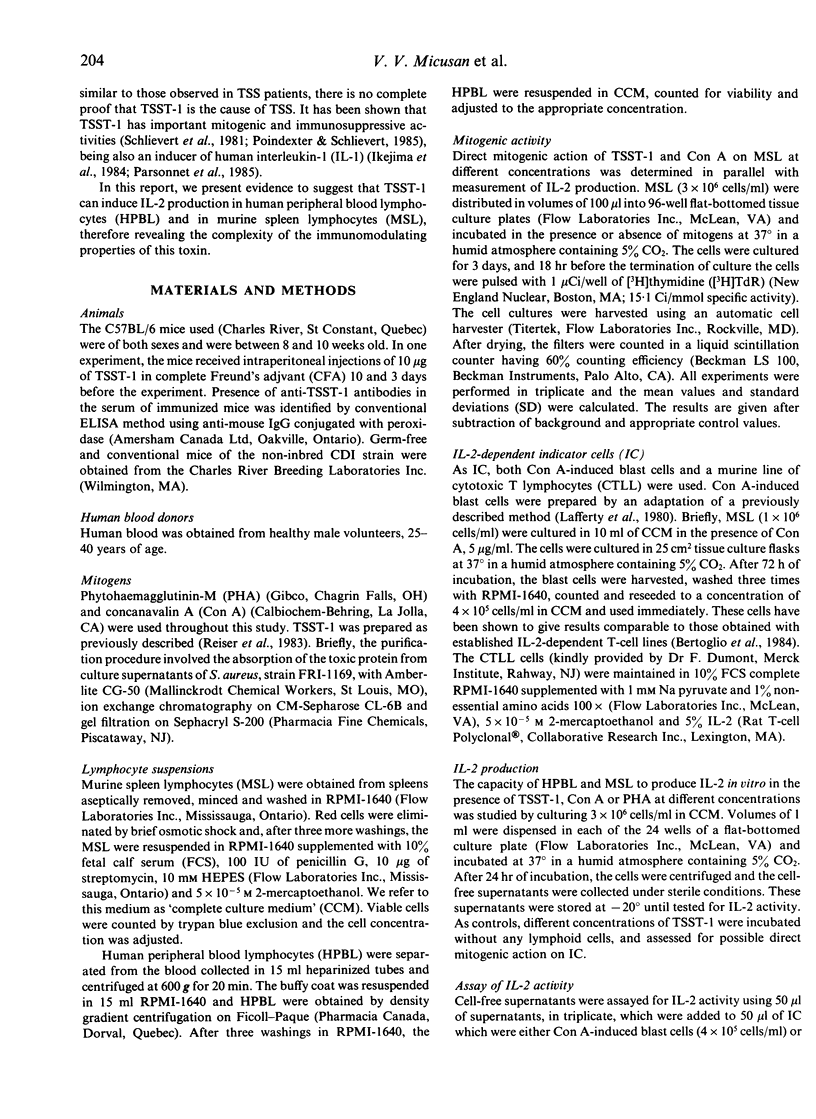
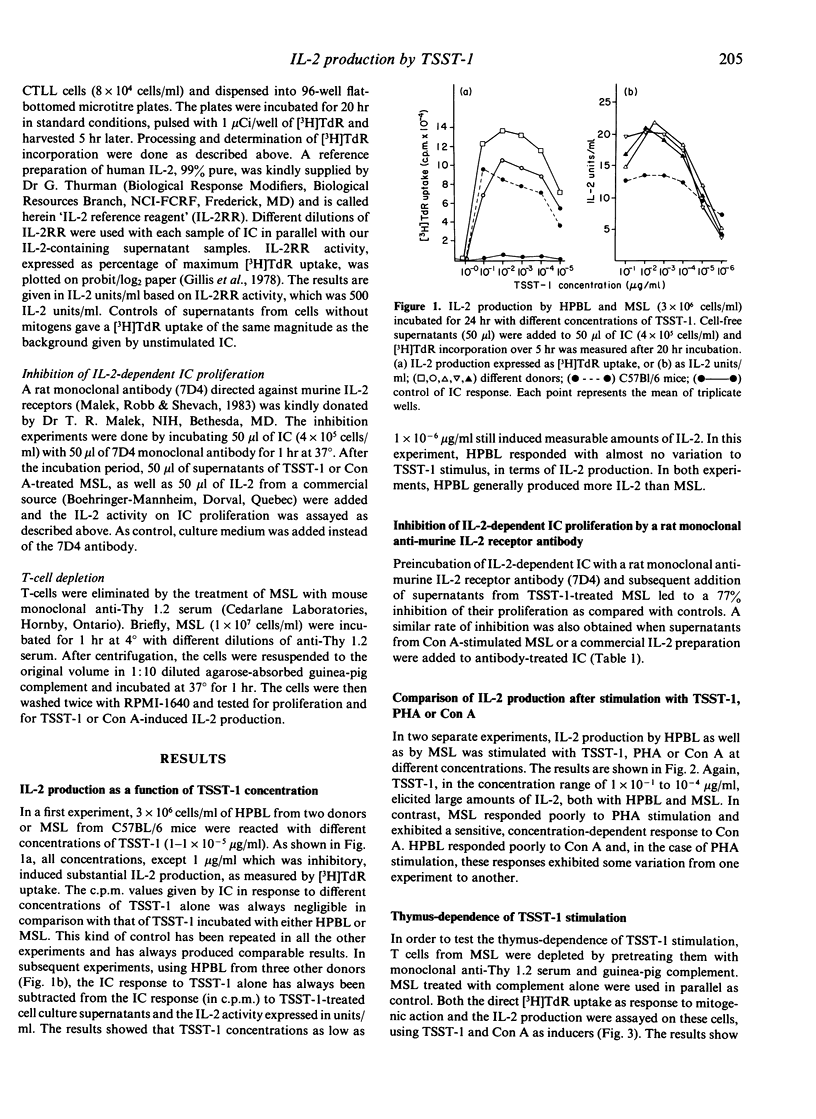
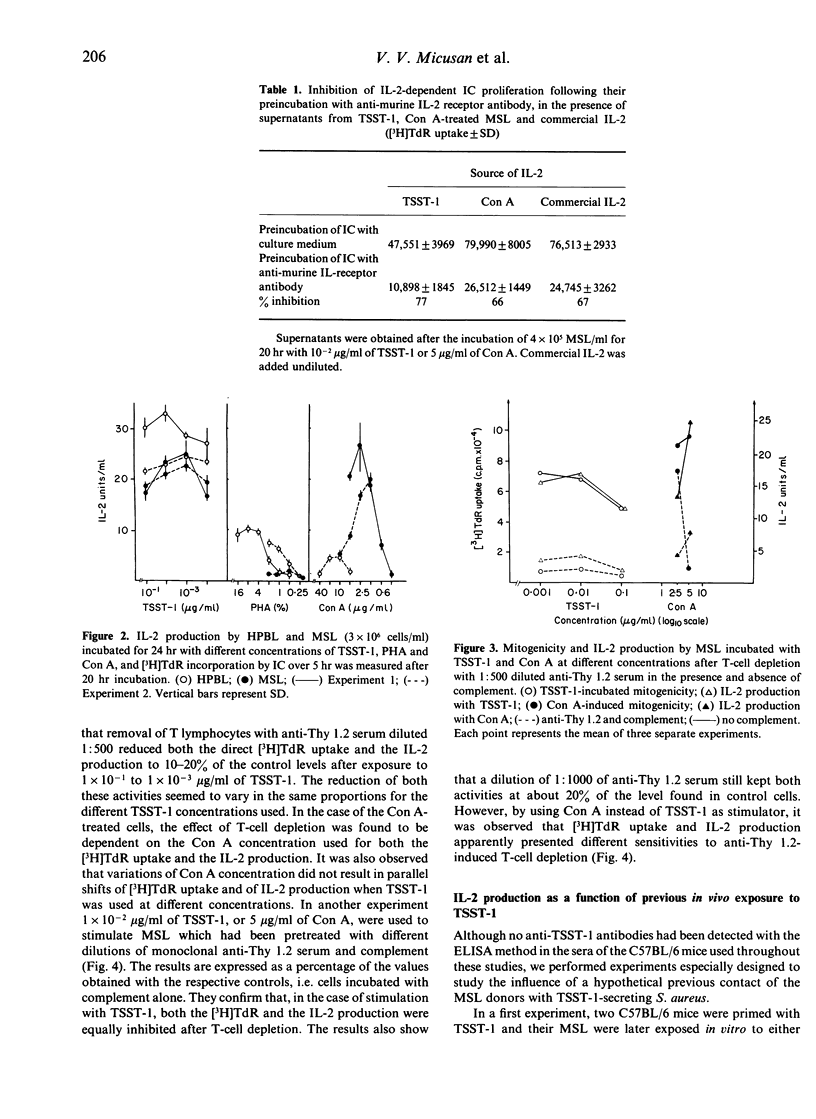
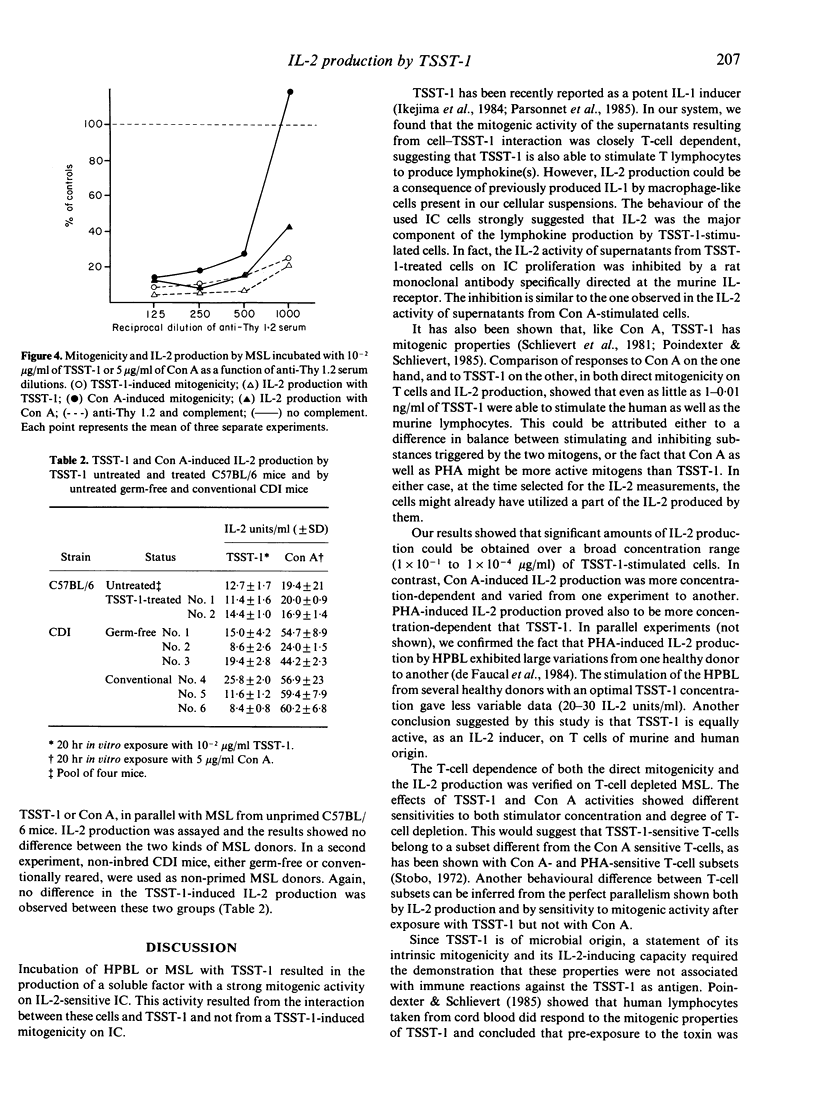
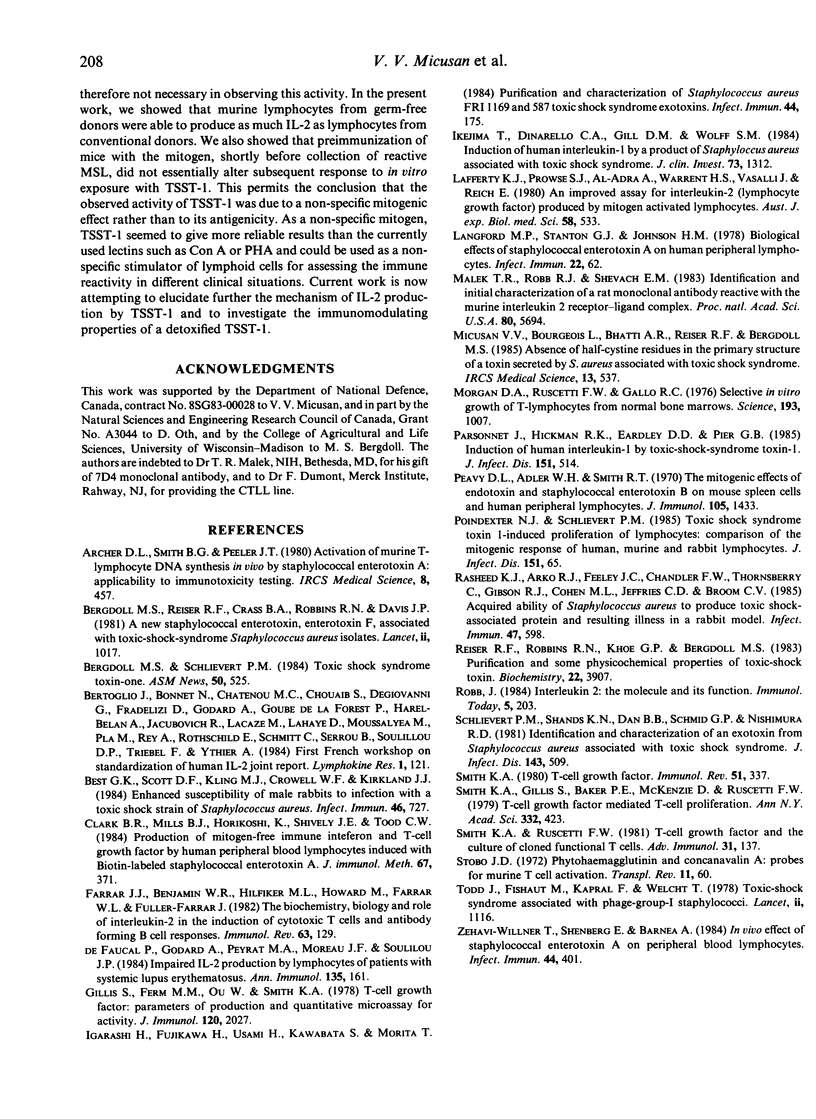
Selected References
These references are in PubMed. This may not be the complete list of references from this article.
- Bergdoll M. S., Crass B. A., Reiser R. F., Robbins R. N., Davis J. P. A new staphylococcal enterotoxin, enterotoxin F, associated with toxic-shock-syndrome Staphylococcus aureus isolates. Lancet. 1981 May 9;1(8228):1017–1021. doi: 10.1016/s0140-6736(81)92186-3. [DOI] [PubMed] [Google Scholar]
- Best G. K., Scott D. F., Kling J. M., Crowell W. F., Kirkland J. J. Enhanced susceptibility of male rabbits to infection with a toxic shock strain of Staphylococcus aureus. Infect Immun. 1984 Dec;46(3):727–732. doi: 10.1128/iai.46.3.727-732.1984. [DOI] [PMC free article] [PubMed] [Google Scholar]
- Clark B. R., Mills B. J., Horikoshi K., Shively J. E., Todd C. W. Production of mitogen-free immune interferon and T-cell growth factor by human peripheral blood lymphocytes induced with biotin-labeled staphylococcal enterotoxin A. J Immunol Methods. 1984 Mar 16;67(2):371–377. doi: 10.1016/0022-1759(84)90476-9. [DOI] [PubMed] [Google Scholar]
- Farrar J. J., Benjamin W. R., Hilfiker M. L., Howard M., Farrar W. L., Fuller-Farrar J. The biochemistry, biology, and role of interleukin 2 in the induction of cytotoxic T cell and antibody-forming B cell responses. Immunol Rev. 1982;63:129–166. doi: 10.1111/j.1600-065x.1982.tb00414.x. [DOI] [PubMed] [Google Scholar]
- Gillis S., Ferm M. M., Ou W., Smith K. A. T cell growth factor: parameters of production and a quantitative microassay for activity. J Immunol. 1978 Jun;120(6):2027–2032. [PubMed] [Google Scholar]
- Igarashi H., Fujikawa H., Usami H., Kawabata S., Morita T. Purification and characterization of Staphylococcus aureus FRI 1169 and 587 toxic shock syndrome exotoxins. Infect Immun. 1984 Apr;44(1):175–181. doi: 10.1128/iai.44.1.175-181.1984. [DOI] [PMC free article] [PubMed] [Google Scholar]
- Ikejima T., Dinarello C. A., Gill D. M., Wolff S. M. Induction of human interleukin-1 by a product of Staphylococcus aureus associated with toxic shock syndrome. J Clin Invest. 1984 May;73(5):1312–1320. doi: 10.1172/JCI111334. [DOI] [PMC free article] [PubMed] [Google Scholar]
- Lafferty K. J., Prowse S. J., Al-Adra A., Warren H. S., Vasalli J., Reich E. An improved assay for interleukin 2 (lymphocyte growth factor) produced by mitogen-activated lymphocytes. Aust J Exp Biol Med Sci. 1980 Dec;58(6):533–544. doi: 10.1038/icb.1980.55. [DOI] [PubMed] [Google Scholar]
- Langford M. P., Stanton G. J., Johnson H. M. Biological effects of staphylococcal enterotoxin A on human peripheral lymphocytes. Infect Immun. 1978 Oct;22(1):62–68. doi: 10.1128/iai.22.1.62-68.1978. [DOI] [PMC free article] [PubMed] [Google Scholar]
- Malek T. R., Robb R. J., Shevach E. M. Identification and initial characterization of a rat monoclonal antibody reactive with the murine interleukin 2 receptor-ligand complex. Proc Natl Acad Sci U S A. 1983 Sep;80(18):5694–5698. doi: 10.1073/pnas.80.18.5694. [DOI] [PMC free article] [PubMed] [Google Scholar]
- Morgan D. A., Ruscetti F. W., Gallo R. Selective in vitro growth of T lymphocytes from normal human bone marrows. Science. 1976 Sep 10;193(4257):1007–1008. doi: 10.1126/science.181845. [DOI] [PubMed] [Google Scholar]
- Parsonnet J., Hickman R. K., Eardley D. D., Pier G. B. Induction of human interleukin-1 by toxic-shock-syndrome toxin-1. J Infect Dis. 1985 Mar;151(3):514–522. doi: 10.1093/infdis/151.3.514. [DOI] [PubMed] [Google Scholar]
- Poindexter N. J., Schlievert P. M. Toxic-shock-syndrome toxin 1-induced proliferation of lymphocytes: comparison of the mitogenic response of human, murine, and rabbit lymphocytes. J Infect Dis. 1985 Jan;151(1):65–72. doi: 10.1093/infdis/151.1.65. [DOI] [PubMed] [Google Scholar]
- Rasheed J. K., Arko R. J., Feeley J. C., Chandler F. W., Thornsberry C., Gibson R. J., Cohen M. L., Jeffries C. D., Broome C. V. Acquired ability of Staphylococcus aureus to produce toxic shock-associated protein and resulting illness in a rabbit model. Infect Immun. 1985 Mar;47(3):598–604. doi: 10.1128/iai.47.3.598-604.1985. [DOI] [PMC free article] [PubMed] [Google Scholar]
- Reiser R. F., Robbins R. N., Khoe G. P., Bergdoll M. S. Purification and some physicochemical properties of toxic-shock toxin. Biochemistry. 1983 Aug 2;22(16):3907–3912. doi: 10.1021/bi00285a028. [DOI] [PubMed] [Google Scholar]
- Schlievert P. M., Shands K. N., Dan B. B., Schmid G. P., Nishimura R. D. Identification and characterization of an exotoxin from Staphylococcus aureus associated with toxic-shock syndrome. J Infect Dis. 1981 Apr;143(4):509–516. doi: 10.1093/infdis/143.4.509. [DOI] [PubMed] [Google Scholar]
- Smith K. A., Gillis S., Baker P. E., McKenzie D., Ruscetti F. W. T-cell growth factor-mediated T-cell proliferation. Ann N Y Acad Sci. 1979;332:423–432. doi: 10.1111/j.1749-6632.1979.tb47136.x. [DOI] [PubMed] [Google Scholar]
- Smith K. A., Ruscetti F. W. T-cell growth factor and the culture of cloned functional T cells. Adv Immunol. 1981;31:137–175. doi: 10.1016/s0065-2776(08)60920-7. [DOI] [PubMed] [Google Scholar]
- Smith K. A. T-cell growth factor. Immunol Rev. 1980;51:337–357. doi: 10.1111/j.1600-065x.1980.tb00327.x. [DOI] [PubMed] [Google Scholar]
- Stobo J. D. Phytohemagglutin and concanavalin A: probes for murine 'T' cell activivation and differentiation. Transplant Rev. 1972;11:60–86. doi: 10.1111/j.1600-065x.1972.tb00046.x. [DOI] [PubMed] [Google Scholar]
- Todd J., Fishaut M., Kapral F., Welch T. Toxic-shock syndrome associated with phage-group-I Staphylococci. Lancet. 1978 Nov 25;2(8100):1116–1118. doi: 10.1016/s0140-6736(78)92274-2. [DOI] [PubMed] [Google Scholar]
- Zehavi-Willner T., Shenberg E., Barnea A. In vivo effect of staphylococcal enterotoxin A on peripheral blood lymphocytes. Infect Immun. 1984 May;44(2):401–405. doi: 10.1128/iai.44.2.401-405.1984. [DOI] [PMC free article] [PubMed] [Google Scholar]
- de Faucal P., Godard A., Peyrat M. A., Moreau J. F., Soulillou J. P. Impaired IL2 production by lymphocytes of patients with systemic lupus erythematosus. Ann Immunol (Paris) 1984 Sep-Oct;135D(2):161–172. doi: 10.1016/s0769-2625(84)81108-3. [DOI] [PubMed] [Google Scholar]


